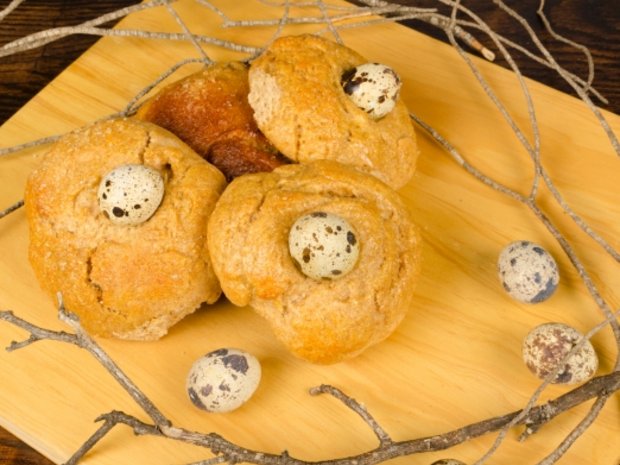Recipes
Ingredients (16 Servings)
- 500 g flour
- 5 g salt
- 15 g fresh yeast (alternatively, one 7 g packet of dry yeast)
- 100 ml water, lukewarm
- 4 eggs
- 80 ml olive oil
- 100 g sugar
- 1 lemon zest
- 1 orange zest
- 4 hard boiled eggs (hens’ eggs or quail eggs ) for decorative purposes
Nutritional values (per serving)
Directions
Mix the yeast with a little warm water and let stand for 10 minutes. During this time, sieve the flour into a bowl, mix with the salt, and form a hollow in the centre. Whisk 3 eggs in a separate bowl.
Next, add the yeast mixture, the rest of the warm water, the whisked eggs, the olive oil, the sugar and the orange and lemon zest to the flour mixture. Knead by hand to create a smooth, soft dough. It may take 10 minutes until the dough is genuinely soft and malleable and no longer sticks.
Cover the dough and leave to rise in a warm place until it has doubled in size (depending on the location, this takes at least 1-2 hours).
Next, divide the dough into four pieces of equal size on a lightly floured work surface and make them into balls. Press them a little flat on the work surface, and using your fingers, create a small depression in the centre of each before gently pressing the hard boiled eggs into each one. Place onto one or two baking trays with baking paper, cover and leave to stand for another hour.
Preheat the oven to 180°C (top/bottom heat).
Whisk an egg and brush the dough with the whisked egg. Bake in the oven for 20-25 minutes until they have nicely risen and are golden. Remove from the oven and leave to cool on a baking rack. Each part provides 4 portions.
Que aproveche!
The decorative eggs are not considered in the calculation.
They are traditionally baked and given as a gift or eaten at Easter - as is the case with most of the traditional dishes, a variety of variations are possible. It is often the case that only one, slightly bigger Mona is baked, or in the form of bunny rabbits, chicks or lambs. In the case of this modern version, there are no limits to your imagination.
Nutrition Tips
Instead of traditionally decorating the Monas with real eggs, those who prefer can also decorate them with chocolate eggs (naturally after baking, and bearing the potassium content in mind), sprinkle decorative sugar over them, or decorate them with sugar icing.
